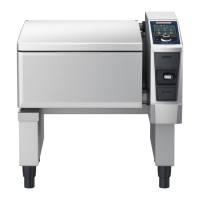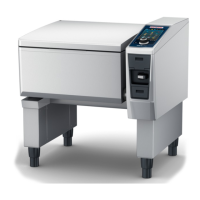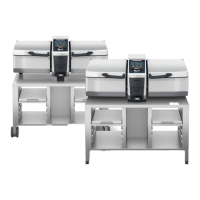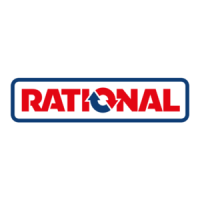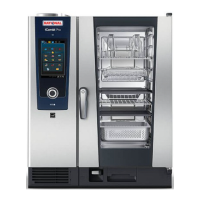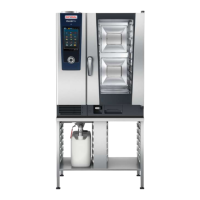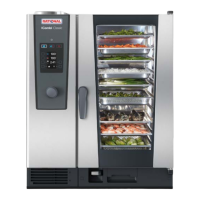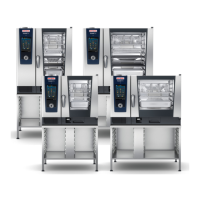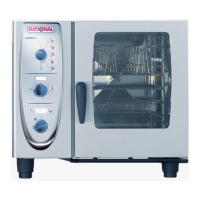


Do you have a question about the Rational iVario Pro L and is the answer not in the manual?
Information on accessing unit help and application examples.
RATIONAL's liability for unauthorized changes or improper use.
Document intended for staff in large and commercial kitchens.
Unit developed for hot food preparation in commercial kitchens.
Guidance on understanding manual conventions and symbols.
Explains DANGER, WARNING, CAUTION, NOTICE signal words and their meanings.
Important checks and actions before operating the unit.
Crucial safety measures to follow while the unit is operating.
Guidelines on wearing appropriate PPE for safe operation and cleaning.
Guidance for the first-time setup and operation of the unit.
Step-by-step instructions for powering the cooking system on and off.
How to save and access frequently used cooking paths and programs.
Explains footer information on date, time, and network connections.
How to access the integrated help function for system guidance.
Explanation of symbols representing various operational actions.
Warning about using pointed objects on the display.
Describes basic touch gestures for operating the unit.
How to use the central dial for setting adjustments and controls.
Guidelines for minimum and maximum fill levels to prevent unit damage.
Specific fill level requirements for pressure cooking.
Information on maximum load capacities for different models.
Step-by-step guide for safely opening and closing the pan lid.
Instructions for using the automatic water refill feature.
Procedures for tilting and lowering the pan safely.
Instructions for safely lowering the pan, including crushing risks.
Steps for operating the pan drain valve, noting conditions for use.
How to properly insert the core temperature probe for accurate cooking.
Instructions for using the hand shower, including spray patterns and safety.
Guidance on adjusting the unit's height for ergonomic benefits.
Lists available cooking modes and methods for food preparation.
Details on various intelligent cooking paths for different food types.
Specific intelligent cooking paths for preparing various meat dishes.
Specific intelligent cooking paths for preparing various fish and seafood dishes.
Specific intelligent cooking paths for vegetables, side dishes, and rice.
Specific intelligent cooking paths for preparing egg-based dishes.
Specific intelligent cooking paths for soups and sauces.
Specific intelligent cooking paths for dairy products and desserts.
Intelligent cooking paths for final preparations and presentations of dishes.
Explains symbols displayed during cooking processes for status and alerts.
Guide to intelligently cooking food.
Two methods for accessing intelligent cooking paths.
Step-by-step guide on initiating an intelligent cooking process.
How to customize cooking parameters for desired outcomes.
Details parameters like Browning, Delta-T, Type of meat, Size, Time, Core probes, and Temperature for result adjustment.
Option to add a new batch of food and continue cooking.
Option to extend the cooking process for a specified duration.
Adjusting core temperature for foods of different sizes during cooking.
Maintaining food temperature to prevent overcooking.
Bringing cooking liquid, soup, or sauce to a boil.
How to view the progress of an intelligent cooking path.
Steps to cancel an active intelligent cooking path.
Explains conditions and warnings during manual cooking.
How to customize manual cooking parameters.
Overview of parameters like temperature and time for manual cooking.
Setting the core temperature for manual cooking.
Adjusting the intensity of boiling.
Explains Preheat, Gentle cooking, and Delta-T cooking functions.
Information on prompts and guidance during manual cooking.
Specifies the temperature range for cooking liquids.
Step-by-step guide for cooking food using manual settings.
Safety precautions specific to frying operations.
Defines the temperature range for frying.
Instructions for frying food using manual settings.
Safety guidelines for frying, including fire hazards and material damage prevention.
Notes on functions not available during deep-frying.
Specifies the temperature range for oil during frying.
Procedures for using the oil cart to fill and empty the pan.
Instructions for melting solid fat for frying.
Recommendations and steps for deep-frying food using baskets.
Steps to cancel a manual cooking process.
Safety precautions for pressure cooking, including risks of burns.
Explains prompts displayed during pressure cooking.
Confirmation of fill quantity and liquid type for pressure cooking.
Procedures for locking and unlocking the pan lid for pressure cooking.
Details on pressurisation and pressure reduction during cooking.
Options available when using pressure cooking with intelligent paths.
Option to extend the cooking process for a specified time.
Step-by-step guide for performing pressure cooking.
Managing cooking programs as tickets.
Using pre-defined cooking programs for various applications.
How to add custom cooking paths or programs to the ticket board.
Steps to remove tickets from the ticket board.
How to add, edit, or manage tickets on the ticket board.
Dividing the pan base into multiple heating zones.
Applying pre-defined zone configurations to the pan.
Customizing the pan division into zones according to specific needs.
Modifying existing pan division setups.
Manually creating zones within the pan without pre-defined divisions.
Assigning cooking tickets or programs to specific pan zones.
Using pre-configured zone assignments for cooking.
Customizing pan allocations and naming them.
Removing custom pan allocation settings.
Methods for cooking food using the iZoneControl feature.
Using manual cooking modes within iZoneControl zones.
Assigning a cooking ticket to a specific zone in the pan.
Adding cooking paths and programs to a shopping basket.
Reviewing items and saving the shopping basket with a name.
Step-by-step guide to creating custom manual cooking programs.
Saving a created manual program.
Customizing intelligent cooking processes.
Options for editing, sending to ticket board, duplicating, or deleting programs.
How to start manual programs, intelligent paths, and shopping baskets.
Selecting a pan division for use.
Setting a future start time for manual programs.
Transferring an iCookingSuite path to an iZoneControl ticket.
Accessing and managing favorite settings.
Configuring display settings like language, date, and time.
Changing the user interface language.
Setting the unit's date, time, and 24h/12h format.
Setting temperature display to Celsius or Fahrenheit.
Selecting volume display in litres or gallons.
Adjusting the display of cooking paths in columns.
Adjusting display brightness.
Adjusting screen brightness on a scale.
Enabling or disabling automatic screen dimming.
Enabling or disabling the screen saver.
Configuring sound settings for the unit.
Adjusting the overall volume of the unit.
Selecting sounds for loading prompts or actions.
Selecting sounds for the end of a program step.
Selecting sounds for when cooking time has elapsed.
Information about the unit model and software version.
Activating demo mode to showcase functionalities.
Activating or deactivating the hot water option.
Setting the primary cuisine for intelligent cooking paths.
Adding a secondary cuisine to influence intelligent cooking paths.
Managing data like programs, profiles, and HACCP data via USB.
Exporting all unit data to a USB flash drive.
Exporting, importing, or deleting created programs.
Deleting all self-created programs from the unit.
Managing user profiles and assigning access rights.
Exporting user profiles to a USB flash drive.
Importing user profiles from a USB flash drive.
Deleting all created user profiles.
Importing and exporting images for programs and carts.
Deleting all imported user images.
Deleting all user-created data, including programs and settings.
Exporting or importing basic unit configuration settings.
Exporting HACCP data to USB or transferring to ConnectedCooking.
Accessing service logs and reports.
Configuring network connections, including WiFi and LAN.
Connecting to wireless networks with hidden SSIDs.
Connecting the unit to a WiFi network.
Connecting the unit to a wired network via LAN.
Entering the unit's IP address.
Entering the Gateway IP address.
Entering the IP netmask.
Entering the primary DNS server address.
Activating or deactivating DHCP for automatic network configuration.
Grouping users and assigning access rights.
Accessing service information and software updates.
Information on available software updates and how to install them.
Connecting the unit to the ConnectedCooking service.
Steps to connect the unit to the ConnectedCooking platform.
Registering the unit without using a smartphone.
Registering the unit using a smartphone and QR code.
Creating, modifying, and assigning rights to user profiles.
Step-by-step guide to creating a new user profile.
Modifying profile names, passwords, languages, and cuisine preferences.
Defining which functions are displayed in the menu bar.
Activating a created user profile for the unit.
Transferring user profiles to different units via USB.
Removing user profiles from the unit.
Managing HACCP data and ensuring hygiene standards.
Information logged for each cooking batch for HACCP compliance.
Downloading HACCP data from the unit.
Setting up automatic transfer of HACCP data to ConnectedCooking.
Connecting units to a network for monitoring and management.
Connecting the unit to a network using an RJ45 Ethernet port.
Steps to establish a wired network connection using LAN.
Steps to establish a wireless WiFi connection.
Remotely monitoring units via ConnectedCooking app or website.
Monitoring units via the ConnectedCooking website.
Monitoring units using the ConnectedCooking smartphone app.
Overview of ConnectedCooking features and benefits.
Detailed steps for connecting the unit to ConnectedCooking.
Registering the unit without using a smartphone.
Registering the unit using a smartphone and QR code.
Setting up automatic software updates via ConnectedCooking.
Updating the unit software using a USB stick.
Safety precautions to follow during cleaning.
Recommended cleaning schedule for unit components.
Suitable and unsuitable cleaning products and agents.
Instructions for cleaning the interior and exterior of the pan.
Detailed steps for cleaning the pan's interior surfaces.
Instructions for cleaning the outer surfaces of the pan.
Cleaning the gasket on the pan lid.
Cleaning the core probe and its cable.
Instructions for cleaning the steam vent(s).
Cleaning the spray regulator, including using a service key.
Cleaning the automatic water filling mechanism.
Cleaning the pan drain valve assembly.
Instructions for cleaning the hand shower and hose.
Cleaning the control panel and central dial, including locking the display.
Cleaning various cooking accessories.
Specific cleaning procedures for units with the pressure cooking option.
Cleaning the locking system of the pan lid.
Cleaning the steam nozzles.
Using the search function to find cooking paths, programs, and settings.
Accessing integrated help content on the unit.
Contacting support via ChefLine or RATIONAL Service Partners.
Information for service calls, including data transfer.
Setting up automatic transfer of service data to ConnectedCooking.
How to retrieve service data from the settings.
Troubleshooting common error messages and issues.
List of error reports and corresponding message texts during cooking.
Error messages specific to the pressure cooking function.
Troubleshooting for power socket issues.
Safety precautions for maintenance activities.
Step-by-step guide to replace the pan lid gasket.
Step-by-step guide to replace the pan drain valve gasket.
Contacting service for unit decommissioning.
Environmentally sound disposal of old units.
Proper methods for disposing of used oil and fat.
Warning against disposing oil/fat through the drain.
Weights of units with the optional pressure cooking function.
Classification of model names and versions.
Information about stickers affixed to the unit.
Guidance on managing acrylamide content during frying.
Compliance with EU directives and machinery standards.
FCC rules and compliance statements for operation in the USA.
| Category | Commercial Food Equipment |
|---|---|
| Model | iVario Pro L |
| Power | Electric or Gas |
| Voltage | 400 V |
| Type | Cooking System |
| Power Supply | 3 NAC 400 V |
| Cooking methods | Boiling, Frying |
| Temperature Range | 30°C to 300°C |
